
Port Austin Was Part of Cold War Defense
In September of 1949, the US Air Force conducted air samples from Eielson Air Force Base in Alaska that they found sent shock waves through the armed forces and government. The samples showed anomalously high levels of airborne radioactive particles. It could only be explained that the USSR had successfully detonated an atomic device.
The SAGE Project
As a result, within two years, a massive project was initiated that exceeded the cost and scope of the Manhattan Project. Initially called Project Lincoln, then the Semi-Automatic Ground Environment, or SAGE. It called for building a network of radars that would automatically identify an unfriendly bomber formation as it approached the U.S. mainland from any direction. The project was completed in 1963.
Michigan’s SAGE Supporting Air Force Stations
Michigan’s northern location on the Canadian border made it a good site for 14 Cold War-era airbases. There were other positions around the state that had an antiaircraft gun or missile installations during the Cold War. Of the 14 bases, only Selfridge Air National Guard Base remains in operation.
Sault St. Marie Air Defense Sector
K.I Sawyer Air Force Base – On 8 November 1958 the Sault Sainte Marie Air Defense Sector was established. The ADC command and control organization’s mission was to operate the Semi-Automatic Ground Environment (SAGE) Data Center, which opened in 1959.
Calumet Air Force Station – 665th Radar Squadron – General Surveillance Radar station. It is located 5.2 miles east-northeast of Phoenix, Michigan. It was closed in 1988
Empire Air Force Station – 752d Radar Squadron (SAGE), 15 July 1963 – 1 April 1966 The station was was closed in 1978 by the Air Force,
Detroit Air Defense Sector
Custer Air Force Station – Located as part of the Army’s Fort Custer Training Center near Battle Creek, Michigan. The site was officially established on 18 April 1953.
Selfridge Air Force Base – 661st Aircraft Control & Warning Squadron (later 661st Radar Squadron (SAGE), Michigan, 1 April 1959 – 1 April 1966.
Port Austin Air Force Station – 754th Aircraft Control & Warning Squadron (later 754th Radar Squadron (SAGE), 1 April 1959 – 1 April 1966. Closed by the Air Force in 1988.
The Development of Port Austin Air Force Station
Port Austin, Air Force Station, was one of twenty-eight stations built as part of the second segment of the Air Defense Command permanent radar network. Prompted by the start of the Korean War, on July 11, 1950, the Secretary of the Air Force asked the Secretary of Defense for approval to expedite the construction of the permanent network. Approval was received on July 21, 1950, by the Defense Secretary. Accordingly, the Air Force directed the Corps of Engineers to proceed with construction.
The radar station was placed into operation in 1952. Over the years, the equipment at the station was upgraded to improve the efficiency and accuracy of the information gathered by the radars. Initially, the site was a Ground-Control Intercept (GCI) and early warning mission. In 1959, the Port Austin Radar station was transitioned to a Semi-Automatic Ground Environment (SAGE). The site was updated again in 1965 to a BackUp Intercept Control (BUIC) system. It remained a BUIC until the station was closed. The site came under Tactical Air Command control in October 1979 with the inactivation of Aerospace Defense Command and the transfer of the site to Air Defense, Tactical Air Command (ADTAC).

In 1982, the main bearing of the search radar failed “catastrophically.” As a result, the FAA long-range radar located in Canton, Michigan, was utilized as a temporary data-tie site until a replacement search radar could be installed at the base in 1983. The site remained in operation until September 1988, when the base was completely shut down.
Today, the former Port Austin Air Force Radar Station site is an economic zone for various industries. It was also the former site of the Port Austin Bible Campus. It’s now owned by Huron Castings, the county’s 5th largest employer, and it will be used for worker housing.
Related Reading About Port Austin Mi
- Port Austin Butterfly House and Gardens – The Port Austin Butterfly House and Gardens give a chance to see various Michigan species of butterflies up close and personal. The 30×50 netted house and surrounding gardens are beautifully landscaped and many of the plants are identified.
- How Art, Kayaking, and a Farm Market Saved Port Austin – The town at the tip of the Thumb has taken a different approach; offer the community has a destination for the entire summer season.
- The Historic Lightship Huron – In Port Huron in a county park, is the Lightship Huron. Lightships are floating lighthouses that could be anchored on the lakes where it was too deep or impossible to build a lighthouse. Lightships displayed a light at the top of a mast and, and in foggy conditions, it sounded a signal. Locals called the Huron “Old B.O.”
- Port Austin was Once a Huge Salt Producer – The first successful attempt to manufacture salt in Michigan was made by the East Saginaw Salt Manufacturing Company in 1859. The success of this company led to the rapid development of the industry in the Saginaw Valley where the blocks were operated in connection with sawmills.



